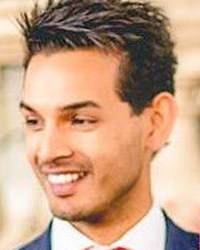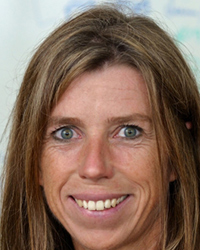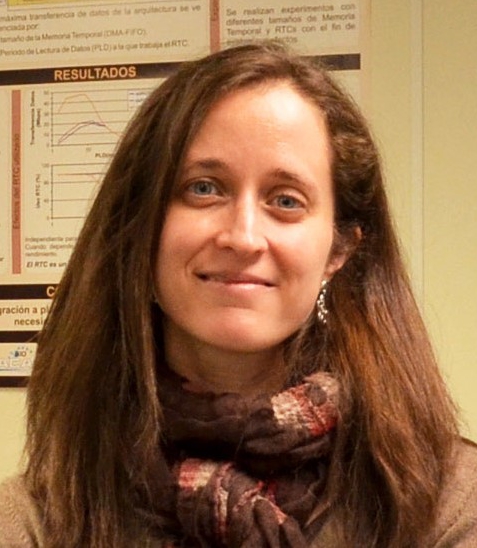PERSONNEL
LAB PERSONNEL | COLLABORATORS | LAB ALUMNI

Wouter-Jan Rappel, PhD
Computational Physicist
University of California, San Diego
Dr. Rappel is a Computational Physicist at the University of California, San Diego Department of Physics and a founding member of the Center for Theoretical Biological Physics. His main research thrust is using computational and analytical approaches to biological and biomedical problems with a particular focus on the electrophysiological dynamics of cardiac arrhythmias. He has published over 100 peer-reviewed articles. Together with Dr. Narayan, he has developed a novel visualization and analysis tool that has enabled them to start unraveling the spatiotemporal organization of electrical wave propagation during atrial fibrillation.

Paul Clopton, MS
Statistician, Research Service, VA San Diego Healthcare Associate Editor, Journal of the American College of Cardiology
Paul Clopton biographical sketch to be updated.

Paul Wang, MD
Professor of Medicine (Cardiovascular Medicine) and, by Courtesy, of Bioengineering Stanford University Medical Center
Dr. Wang’s research centers on the development of innovative approaches to the treatment of arrhythmias, including more effective catheter ablation techniques, more reliable implantable devices, and less invasive treatments. Dr. Wang’s clinical research interests include atrial fibrillation, ventricular tachycardia, syncope, and hypertrophic cardiomyopathy. Dr. Wang has active collaborations with Bioengineering, Mechanical Engineering, and Electrical Engineering Departments at Stanford. Some of the goals of his research program are: 1) to create a more effective methods of catheter ablation, 2) to create implantable pacemakers and leads that are more reliable, 3) to create a combined surgical-catheter approach to ablation, 4) to create noninvasive methods of ablation, 5) to make defibrillation painless.

Mohan Viswanathan, MD
Clinical Associate Professor
Associate Director of Electrophysiology
Stanford University School of Medicine
Dr. Mohan Viswanathan is a Clinical Associate Professor of Medicine in the Division of Cardiovascular Medicine, in the Arrhythmia and Electrophysiology Section. He is the Director of the Cardiac Electrophysiology Laboratory and Associate Director of Electrophysiology. His research interests have focused on stem cell research in the mitigation of ventricular arrhythmias as well as clinical studies on management of ventricular arrhythmias by catheter ablation techniques and neural modulation. He is currently also working closely with Dr. Sanjiv Narayan here at Stanford in implantation of many clinical studies on using Rotor mapping and ablation in atrial and ventricular arrhythmias. He has also done collaborative work with Dr. Melvin Scheinman at UCSF on mechanism differentiation in supraventricular tachycardias. Dr. Viswanathan earned a B.S. degree in BioEngineering at University of California, Berkeley, and an M.D. degree from University of California, San Francisco. He went to the University of Pennsylvania to complete his internal medicine residency and returned to the University of California, San Francisco for fellowship training in Cardiology and Cardiac Electrophysiology. Between 2007 and 2014, he was Assistant then Associate Professor of Medicine at the University of Washington in Seattle, Washington before being recruited to Stanford in 2014.

Marco Perez, MD
Assistant Professor of Medicine (Cardiovascular Medicine)
Stanford University
Dr. Marco Perez’s research goal is to better understand the fundamental causes of cardiovascular disease through the study of genetics and epidemiology. His group studies the genetic variations and environmental exposures that are associated with conditions such as atrial fibrillation and heart failure. He has led the studies of atrial fibrillation in Women’s Health Initiative, one of the largest nation-wide population-based cohorts. He is interested in understanding the paradox that atrial fibrillation is less common in African Americans and Hispanics, despite a greater burden of risk factors such as hypertension. As director of the Stanford Inherited Arrhythmia Clinic, he evaluates families with rare inherited arrhythmias associated with sudden death such as Long QT and Brugada Syndromes and explores their links with novel genes. He also studies how best to use the electrocardiogram to identify patients at risk for atrial fibrillation and athletes at risk for life-threatening arrhythmias due to conditions such as hypertrophic cardiomyopathy. His genetic studies have led to the discovery of promising novel therapeutic targets that his group is now studying at a functional level. Dr. Perez receives funding from NIH, the Robert Wood Johnson Foundation, AHA, Stanford Cardiovascular Institute and the Stanford SPARK program.

Junaid Zaman, MD
ELECTROPHYSIOLOGIST
Dr. Zaman is a clinician scientist specializing in heart rhythm disorders. He obtained his medical degree from University of Oxford, graduating with distinctions and a First Class degree. After completing his postgraduate Membership of the Royal College of Physicians exams in record time whilst on the London Postgraduate Hospitals Rotation, he became a National Institute for Health Research academic clinical cardiology fellow in first Manchester and then London Deaneries. He was awarded both a Medical Research Council Chain Florey Fellowship and a British Heart Foundation to read for a PhD at the National Heart and Lung Institute, Imperial College London and investigated the relation between electrical signals in atrial fibrillation (AF) and underlying tissue structure. He has been recognized as a future leader in his field by the Heart Rhythm Society and European Society of Cardiology with awards at international scientific meetings. He has also won multiple travel awards, most recently from the British Cardiac Society and Stanford Cardiovascular Institute. His research presentation won 1st place at the European Cardiac Arrhythmia Society Annual Congress in Paris in April 2015. He was a finalist in the Samuel Levine Young Investigator Awards Competition of the American Heart Association in Orlando, FL in November 2015. Junaid was awarded the inaugural US-UK Fulbright British Heart Foundation Research Scholar Award. This has consolidated his Imperial-Stanford collaboration between Dr. Nicholas Peters and Dr. Sanjiv Narayan, and will allow him to pursue the science behind, and test the clinical benefits of these new therapies applied to AF and life threatening ventricular arrhythmias.

Ellen Kuhl, PhD
Associate Professor of Mechanical Engineering and Cardiothoracic Surgery Stanford University
Dr Kuhl’s area of professional expertise is living matter physics, the creation of theoretical and computational models to predict the acute and chronic response of living structures to environmental changes during development and disease progression. Her specific interest is the multiscale modeling of growth and remodeling, the study of how living matter adapts its form and function to changes in mechanical loading, and how this adaptation can be traced back to structural alterations on the cellular or molecular levels. Growth and remodeling might be induced naturally, e.g., through elevated pressure, stress, or strain, or interventionally, e.g., through prostheses, stents, tissue grafts, or stem cell injection. Combining theories of applied mathematics, biophysics, and continuum mechanics, her lab has specialized in predicting the evolution of form and function in living structures using patient-specific custom-designed finite element models. These models can serve as diagnostic and predictive tools to explain human brain development and malformations associated with neurological disorders such as lissencephaly, polymicrogyria, schizophrenia, and autism.

Chad Brodt, MD
Clinical Assistant Professor of Electrophysiology, Stanford University School of Medicine
Dr. Chad Brodt specializes in the diagnosis and management of heart rhythm disorders. He performs catheter ablation to treat conditions of fast rhythms such as supraventricular tachycardia, atrial flutter, atrial fibrillation and ventricular tachycardia. In addition he performs implantation procedures of devices such as pacemakers for slow heart rhythms as well as defibrillators and biventricular pacing devices for individuals with heart failure or risk of fatal arrhythmias. He is currently interested in improving our understanding and utilization of low radiation techniques when performing electrophysiologic procedures. He is an active participant in the Stanford Arrhythmia Service’s multiple ongoing clinical trials to further the advancement in this field.

Phil Yang, MD
Associate Professor of Medicine (Cardiovascular Medicine)
Director, Cardiothoracic MRI Program
Stanford University Medical Center
Phillip C. Yang is an Associate Professor of Medicine (Cardiovascular Medicine) at the Stanford University School of Medicine. He directs the Cellular and Molecular Imaging Lab (Yang Lab) and Stanford Cardiothoracic MRI Program. Dr. Yang received degrees from Stanford University and Yale University School of Medicine, and completed post-graduate training at UCLA and Stanford University Medical Centers. Dr. Yang is a physician-scientist whose research interest focuses on clinical translation of the fundamental molecular and cellular processes of myocardial restoration. His research employs novel in vivo multi-modality molecular and cellular imaging technology to translate the basic innovation in small molecules. Dr. Yang is currently a PI on the NIH/NHLBI funded CCTRN UM1 grant, which is designed to conduct multi-center clinical trial on novel biological therapy. In addition, he is a PI on 3 NIH research grants, 1 CIRM grant, and leads 3 stem cell clinical trials. He hopes to pioneer the Cardiovascular Regeneration Program at Stanford. Dr. Yang has been the recipient of several prestigious awards including NIH Career Development Award, NIH Career Enhancement Award, and NIH Patient Oriented Research. To find out more, please visit the Yang Lab website: http://med.stanford.edu/cvmedicine/research/faculty-labs-link/yanglab.html

Minang (Mintu) Turakhia, MD
Assistant Professor of Medicine (Cardiovascular Medicine) and Health Research and Policy
Director of Cardiac Electrophysiology, Palo Alto Veterans Affairs Healthcare System
Stanford University
Dr. Turakhia is a cardiac electrophysiologist, outcomes researcher, and Assistant Professor of Medicine at Stanford University. He is Director of Cardiac Electrophysiology at the Palo Alto VA Health Care System and is an Associate Investigator at the Center for Health Care Evaluation (CHCE). In his clinical role, Dr. Turakhia performs catheter ablation, device implantation, and lead extraction. Dr. Turakhia has an active clinical research program, with funding from AHA, VA, NIH, the medical device industry, and foundations. His research program aims to improve the treatment of heart rhythm disorders, by evaluating quality and variation of care, comparative and cost-effectiveness of therapies, and risk prediction. Dr. Turakhia has extensive expertise in using large administrative and claims databases for this work. His TREAT-AF retrospective study of over 400,000 patients with newly-diagnosed AF is the largest known research cohort of AF patients. His other research interests include technology assessment of new device-based therapies and the impact of changing health policy and reform on the delivery of arrhythmia care. Dr. Turakhia is a Fellow of the American Heart Association, American College of Cardiology, and Heart Rhythm Society.

Maria Guillem, PhD
Professor of Information Technology and Communication
Polytechnic University of Valencia (UPV)
Dr. Guillem is a telecommunications engineer (Polytechnic University of Valencia, 2003), with an MS in Biomedical Engineering (Northwestern University, 2006) with a Fulbright scholarship and doctorate in Electrical Engineering (2008). Currently, she is an assistant professor in the Department of Electrical Engineering at UPV and is developing her research career in the Institute of Applied Technologies of Technology and Information and Advanced Communication (ITACA) in UPV. Her research interests include biomedical signal processing with a primary interest in cardiac signals.

Andreu Climent, PhD
Post-Doctoral Researcher Gregorio Marañón Hospital Polytechnic University of Valencia
Andreu M. Climent has a PhD in Electronic Engineering from the Universitat Politècnica de Valencia since 2011. He is currently a post-doctoral researcher at the Gregorio Marañón Hospital in Madrid.
Currently, Dr. Climent is focused on the area of cardiac electrophysiology research of the Laboratory of Bioartificial Organs of the Gregorio Marañón Sanitary Research Institute. Among the main lines of research of Dr. Climent include: – Tissue engineering and cellular therapies for post-infarction cardiac tissue regeneration. – Experimental techniques for mapping cardiac arrhythmias (i.e. optical cartography on in-vitro cultures and isolated porcine heart).Non-conventional techniques for the characterization of cardiac arrhythmias (i.e. non-invasive and endocardial electrical mapping during supraventricular arrhythmias). As a researcher, Dr. Climent is coauthor of more than 30 scientific articles in JCR journals, has participated in various competitive research projects, has directed 2 doctoral theses and more than 30 final projects of degree or master. In addition, Dr. Climent is a member of the Ethics and Animal Experimentation Committee of the Gregorio Marañón Hospital in Madrid.

Felipe Atienza, MD, PhD
Associate Professor of Medicine (Cardiovascular Medicine) and Senior Electrophysiologist
University Hospital Gregorio Marañón
Felipe Atienza earned his MD degree at the University of Valencia. After completing the residency program in Cardiology at the Hospital General Universitario de Valencia, he defended PhD thesis at the University of Valencia for a bioinformatics project developed in collaboration with Universidad Politécnica de Valencia and Harvard University-MIT. He obtained the Master Degree in Clinical Cardiac Electrophysiology at the Universidad Complutense of Madrid. In 2002 he moved to the University Hospital Gregorio Marañón Hospital, in Madrid, Spain, where he serves as Senior Electrophysiologist and Associate Professor of Medicine. He is Cardiovascular Research Coordinator of the Cardiology Department, University Hospital Gregorio Marañón. The Laboratory of Translational Cardiovascular Research (LITEC), is formed by a multidisciplinary team that involves physicians, cardiologists, bioengineers, biologists, pharmacists, and basic scientist. Our final objective is to develop new and effective approaches for the diagnosis and effective treatment of cardiovascular diseases. Our lab has studied atrial and ventricular arrhythmias in humans, animal and computer models, electrophysiology of regenerated cardiac tissue and stem cells, and conducted randomized clinical trials evaluating novel therapies in the field of cardiac arrhythmias.
